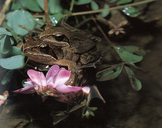|
Description
Rana tsushimensis is slender bodied frog. The snout-vent length range of males is range 31 - 37 mm and of females is 37 - 44 mm. The canthus is blunt and concave. The tympanum is circular, and there are 2 - 6 vomerine teeth which are oval. There is moderate webbing, where the broad webbing leaves 1 - 2 phalanges in males and 2 - 3 in females free on the outer margin of 4th toe. The inner metatarsal tubercle is elliptical, and the outer one is small but distinct. The skin on the back of the frog is covered with small granules which have asperities on them. The dorsolateral fold is evident, slightly flaring outwards above tympanum, and the supratympanic fold is blunt. There is no vocal sac or vocal opening and the nuptial pads in males (Maeda and Matsui 1990).
The nupitial pads are grayish brown (Maeda and Matsui 1990).
Distribution and Habitat
Country distribution from AmphibiaWeb's database: Japan
This species inhabits plains and hillsides and is endemic to Tsushima, Japan. The type locality is Tsushima Island (Maeda and Matsui 1990).
Life History, Abundance, Activity, and Special Behaviors
This species breeds from January to April in still waters in rice fields, ponds, ditches and pools. It is often sympatric with R. dybowskii. However, different calls seem to prevent hybridization. Females lay approximately 400 - 500 eggs each. The eggs have a diameter of 1.7 - 2.3 mm (Maeda and Matsui 1990).
Mating call duration is 1 sec with 3 - 5 notes. Dominating frequency 2.1 kHz, with marked frequency modulation and clear harmonics (Maeda and Matsui 1990).
Larva
The larva usually have a dark spot on each side of their back (Maeda and Matsui 1990).
Comments
Rana tsushimensis is sometimes regarded as a subspecies of R. amurensis, but it isn't, because artificially produced hybrid embryos between R. tsushimensis and R. a. coreana are not viable. The species is closely related to R. okinavana, and these probably bridge R. japonica and R. tagoi (Maeda and Matsui 1990).
Diploid chromosome (2n), with 5 large pairs and 8 small ones making a total of 26 chromosomes (Maeda and Matsui 1990).
References
Maeda, N. and Matsui, M. (1990). Frogs and Toads of Japan, 2nd edition. Bun-Ichi Sogo Shuppan Co., Ltd., Tokyo, Japan.
Originally submitted by: Ambika Sopory (first posted 2000-10-13)
Edited by: Vance T. Vredenburg (2023-05-02)Species Account Citation: AmphibiaWeb 2023 Rana tsushimensis: Tsushima Brown Frog <https://amphibiaweb.org/species/5173> University of California, Berkeley, CA, USA. Accessed Jun 3, 2025.
Feedback or comments about this page.
Citation: AmphibiaWeb. 2025. <https://amphibiaweb.org> University of California, Berkeley, CA, USA. Accessed 3 Jun 2025.
AmphibiaWeb's policy on data use.
| 




 Map of Life
Map of Life